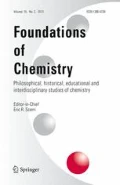REFERENCES
C.W. Bauschlicher, P. Siegbahn and G.M. Petterson. The Atomic States of Nickel. Theoretica Chimica Acta 74: 479–491, 1988.
T.Y. Cao (Ed.). Structural Realism and Quantum Field Theory, Special Issue, Synthese 136, 2003.
N.C. Cartwright. How the Laws of Physics Lie. Oxford: Clarendon Press, 1983.
P. Galison and D. Stump (Eds.). The Disunity of Science. Stanford, California: Stanford University Press, 1996.
P.M.W. Gill. In v.R. Schleyer (Ed.), Encyclopedia of Computational Chemistry, Vol. 1, pp. 678–689. Chichester: Wiley, 1998.
W.J. Hehre, L. Radom, P.v.R. Schleyer and J. Pople. Ab Initio Molecular Orbital Theory. New York: John Wiley, 1986.
R. Hoffmann, B. Minkin, and B. Carpenter. Ocham's Razor and Chemistry. Bulletin de la Societée Chimique Française 133: 117–130, 1996.
S. Kais, S.M. Sung and D.R. Herschbach. Large-Z and-N Dependence of Atomic Energies of the Large-Dimension Limit. International Journal of Quantum Chemistry 49: 657–674, 1994.
M.P. Melrose and E.R. Scerri. The Authors Reply to “Why the 4s Orbital Is Occupied before the 3d”. J. Chem. Educ. 74: 616–616, 1997.
C.A. Moore. Tables of Atomic Energies....
V.N. Ostrovsky. How and What Physics Contributes to Understanding the Periodic Law. Foundations of Chemistry 3: 145–182, 2001.
K. Raghavachari and G.W. Trucks. Highly Correlated Systems. Ionization Energies of First Row Transition Metals Sc-Zn, Journal of Chemical Physics 91: 2457–2460, 1989.
E.R. Scerri. Transition Metal Configurations and Limitations of the Orbital Approximation. J. Chem. Educ. 66: 481–483, 1989.
E.R. Scerri. How Good Is the Quantum Mechanical Explanation of the Periodic System? Journal of Chemical Education 75: 1384–1385, 1998.
E.R. Scerri. The Failure of Reduction and How to Resist the Disunity of Science in Chemical Education, Science and Education 9: 405–425, 2000.
E.R. Scerri. Have Orbitals Really Been Observed? Journal of Chemical Education 77: 1492–1494, 2000.
L.G. Vanquickenborne, K. Pierloot and D. Devoghel. Electronic Configurations and Orbital Energies. Inorganic Chemistry 28, 1805–1813, 1989.
L.G. Vanquickenborne, K. Pierloot and D. Devoghel. Transition Metals and the Aufbau Principle. Journal of Chemical Education 71: 469–471, 1994.
A. Wang and E.A. Carter. In S.D. Schwartz (Ed.), Theoretical Methods in Condensed Phase Chemistry, pp. 117–184. Dordrecht: Kluwer, 2000.
Author information
Authors and Affiliations
Rights and permissions
About this article
Cite this article
Scerri, E.R. Just how ab initio is ab initio quantum chemistry?. Foundations of Chemistry 6, 93–116 (2004). https://doi.org/10.1023/B:FOCH.0000020998.31689.16
Issue Date:
DOI: https://doi.org/10.1023/B:FOCH.0000020998.31689.16

